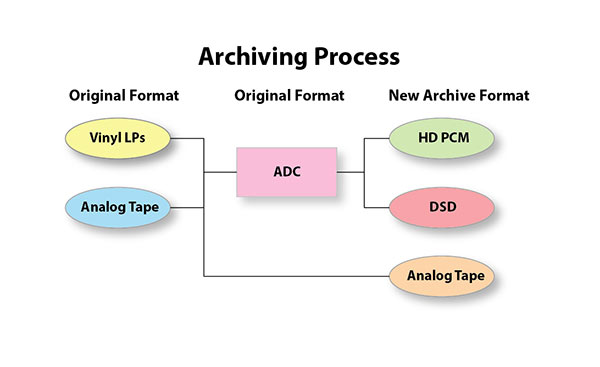Updating the Past Part IV
Any time you’re dealing with analog signals, it is required that you have reference tones to calibrate the outputs and inputs of any transfers. This includes the archiving of your older format analog tapes and vinyl LPs to a digital format. There is no point is producing a copy of the analog material in a digital format that doesn’t sound as good as the original.
By now I hope readers of these pots understand that the potential fidelity of a high-resolution or high-definition PCM digital file is greater than that of the analog sources you want to preserve. This is, as you would want it to be…although there are valid reasons for copying and analog master to another analog format, as we’ll see below.
Here’s a diagram of the setup for transferring analog sources to digital or analog backups.
Figure 1 – A diagram showing the various components for archiving analog sources to digital or analog backups.
The items on the left of the graphic show the original source formats. The analog to digital converter is in the center. ALL of the signals that pass between your turntable and tape deck are analog and require careful level adjustment at the output of the source and the input level of the ADC. Most of the time, analog electronic outputs operate best at full volume (this is true for power amplifiers as well). If you have a high quality analog tape machine the output levels are calibrated according the scheme we discussed previously. You should check the manual of your phono preamplifier stage for the best signal to noise ratio, but I suspect it’s at the top of the scale.
This is then matched to the input level of the ADC. This level establishes how many bits of your HD PCM words will be used during the conversion. You want to use all 24-bits if possible. But you don’t want to go over. There is no going over in digital. No soft or gradual move into distortion like there is in analog electronics. It’s true that sometime designers of digital equipment will provide a buffer of a couple of dB from the real peak but don’t count on it. The point is to use as much of the digital capability as possible. Don’t assume that digital is “inherently” quiet and that you can get away with any level on the digital meters. If you don’t get enough level through the conversion process, you might actually be adding noise unnecessarily to your archive copies.
The output of the ADC is a digital stream of binary information. The storage of that information is handled by with a PCM or DSD recorder. When played back, the digital stream is converted back to analog.
The final installment comes tomorrow…


